Tuesday Sept. 25, 2007
Quiz #1 was returned in class. Please check your quiz
carefully
for grading errors and make sure the points were added up
correctly. Some people did very well on the quiz, others didn't
do as well as they might have hoped. Here are some suggestions that you might
consider.
The Experiment #1 reports were also returned today. You may
revise your report if you wish, revised reports are due in two weeks on
Tue., Oct. 9. Please
return the original report with your revised report.
There is a new Chapter 2 reading
assignment.
Chapter 2
is concerned with energy, temperature, heat, energy transport, energy
balance between the earth, atmosphere, and space. It is easy to
lose sight of the main concepts because there are so many
details. The following (found on pps 43&44 in the photocopied
Class Notes) is meant to introduce some of what we will be covering in
class from Chapter 2.
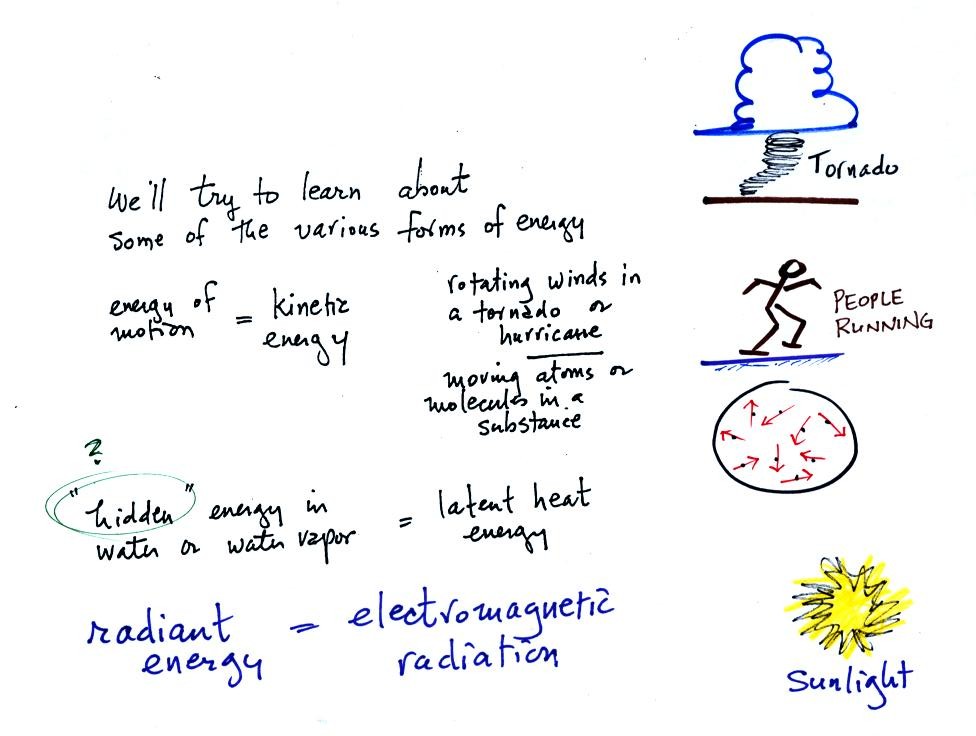
We will learn the names of several different types or forms of
energy. Kinetic energy is energy of motion. Some examples are mentioned
and sketched above. It is a relatively easy to visualize and
understand form of energy.
Latent heat energy is perhaps the most underappreciated and most
confusing type of energy. The word latent refers to energy that is
hidden in water and water vapor. This energy can emerge when
water vapor condenses or water freezes.
Radiant energy is a very important form of energy that was for some
reason left off the original list. Sunlight is an example of
radiant energy that we can see and feel (you feel warm when you stand
in and absorb sunlight). There are many types of radiant energy
that are invisible.
The four energy transport
processes are listed below.
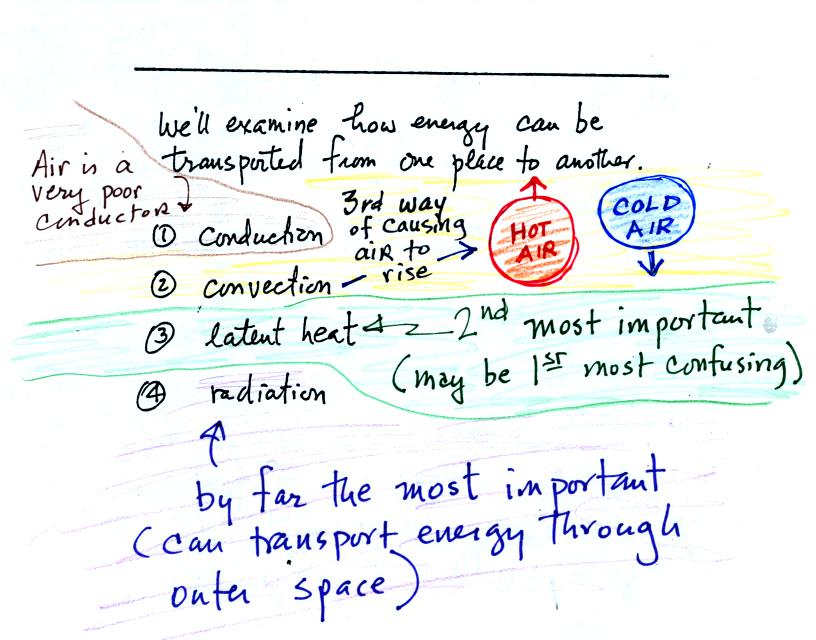
By far the
most important process is electromagnetic radiation (light is a common
form of electromagnetic radiation). This is the
only process that can transport energy through empty space.
Electromagnetic radiation is also responsible for about 80% of the
energy transport between the ground and atmosphere.
You might be
surprised to learn that latent heat is the second most important
transport process.
Rising parcels of warm air and sinking parcels of cold air are
examples of convection. Because of convection you feel colder or
a cold windy day than on a cold calm day. Note that convection is
a 3rd way of causing rising air motions in the atmosphere (convergence
into centers of low pressure, and fronts were the other two ways).
Ocean currents are also an example of convection. Ocean currents
transport energy from the warm tropics to colder polar regions.
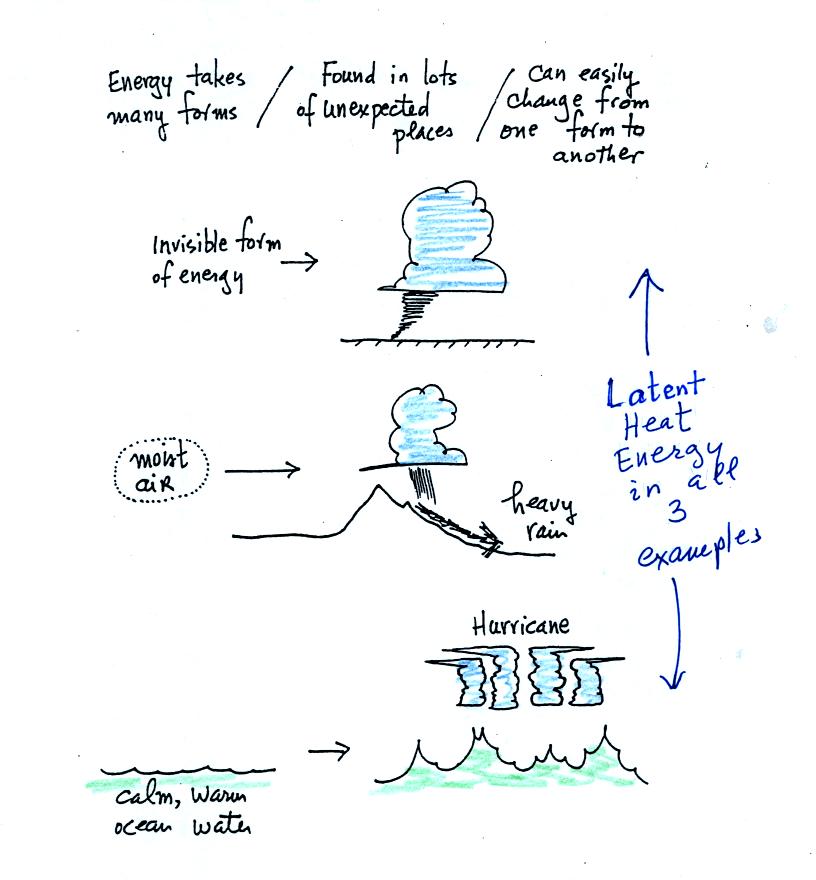
Water vapor is a particularly important form of invisible
energy.
When water vapor condenses to produce the water droplets (or ice
crystals) in a
cloud, an enormous amount of latent heat energy is released into the
atmosphere.
It is hard to visualize or appreciate the amount of energy released
into the
atmosphere during condensation. You can imagine the work that you
would do carrying a gallon of water
(8 pounds) from Tucson to the top of Mt. Lemmon. To
accomplish
the same thing Mother Nature must first evaporate the water and (if my
calculations are correct) that requires about 100 times the energy that
you would use to carry the 8 pounds of water to the summit of Mt.
Lemmon. And Mother Nature transports a lot more than just a
single gallon.
The next picture shows energy being transported from the sun to
the earth in the form of electromagnetic radiation.

We are aware of this energy because we can see it (sunlight
also contains invisible forms of light) and feel it. With all of
this energy arriving at and
being
absorbed by the earth, what keeps the earth from getting hotter and
hotter? The answer is that the earth also sends energy back into
space (the orange and pink arrows in the figure below)
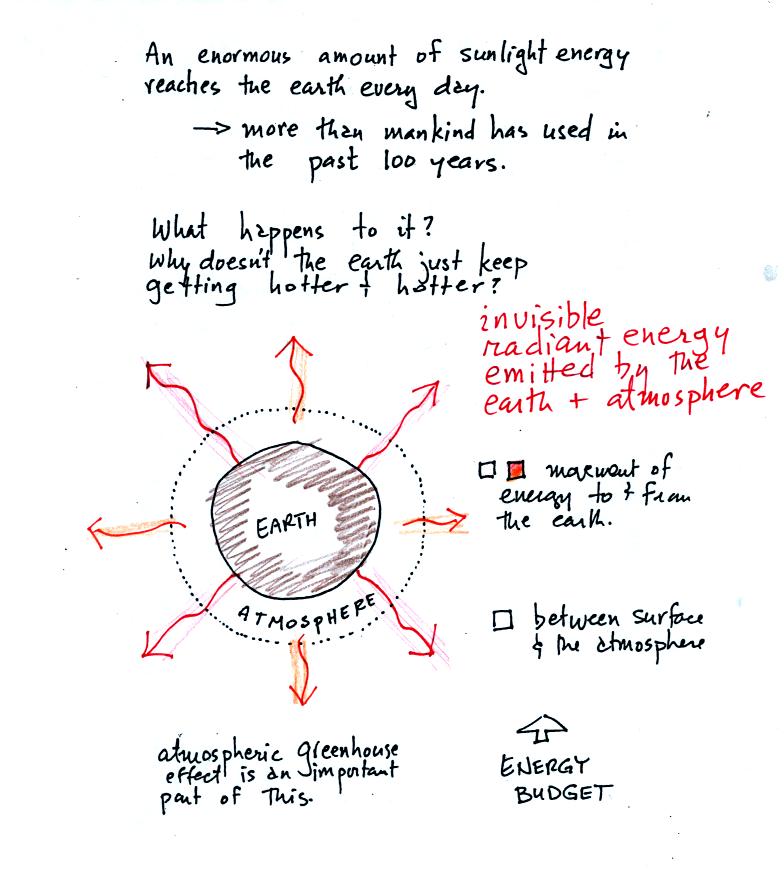
This infrared light is an
invisible form of energy (it is weak enough that we
don't usually feel it either). A balance
between incoming and outgoing energy is achieved and the earth's annual
average temperature remains constant.
We will also look closely at energy transport between the earth's
surface and the atmosphere. This is where latent heat energy transport
and convection and conduction operate (they can't transport energy past
the atmosphere and into outer space).

That is also where the atmospheric
greenhouse operates. That will be a important goal in Chapter 2 -
to
better understand how the atmospheric greenhouse effect works.
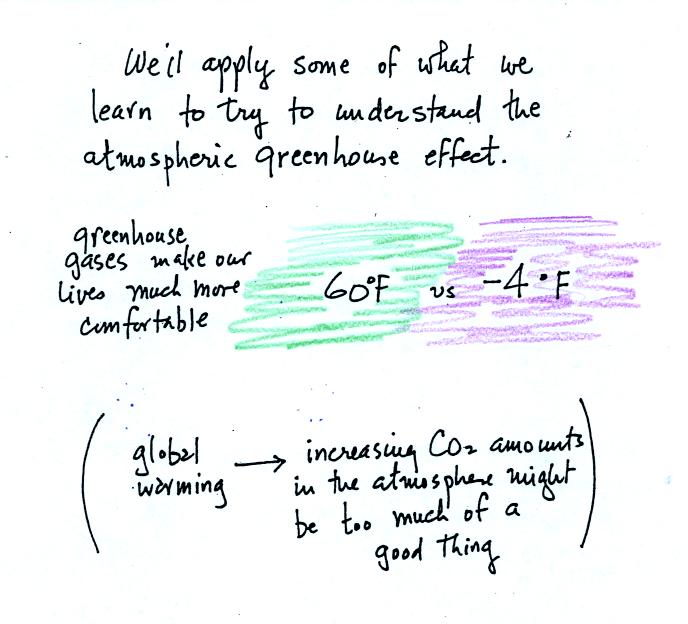
Remember that without the greenhouse effect, the global annual
average surface temperature on the earth would be about 0o F
rather
than 60o F.
I've taken
the information on p. 45 in the photocopied notes and split it into two
parts.
When you add energy to an object, the object will usually
warm
up. It is relatively easy to come up with an equation that allows
you to figure out what the temperature change will be.

When you add energy to something the temperature change will
depend on
how much energy was added. So delta E is in the numerator of the
equation. When you add equal amounts of energy to a small pan of
water and to a large pan of water, the small pan will heat up more
quickly. The temperature change, delta T, will depend on the
mass. A large mass will mean a small delta T, so mass should go
in the denominator of the equation. Different materials
react differently when energy is added to them. A material with a
large specific heat will warm more slowly than a material with a small
specific heat. Specific heat behaves in the same kind of way as
mass. Specific heat is sometimes called "thermal mass."
Note the alternate form of the equation. If you know the mass and
specific heat of an object and observe the object warm or cool, you
could use a measurement of the temperature change (delta T) to
calculate how much energy was
added to or removed from the object. We made use of this form of
the equation in a class experiment.
An object will usually warm when you add energy to it. But there
is another possibility (mentioned at the bottom of the figure).
The object could change phase (change from solid to liquid or
gas). Adding energy to ice might cause
the
ice to melt. Adding energy to liquid nitrogen could cause the
nitrogen to
evaporate and turn into nitrogen gas.
If you want to melt (evaporate) a certain amount of material the
equation could be used to compute how much energy would be needed.
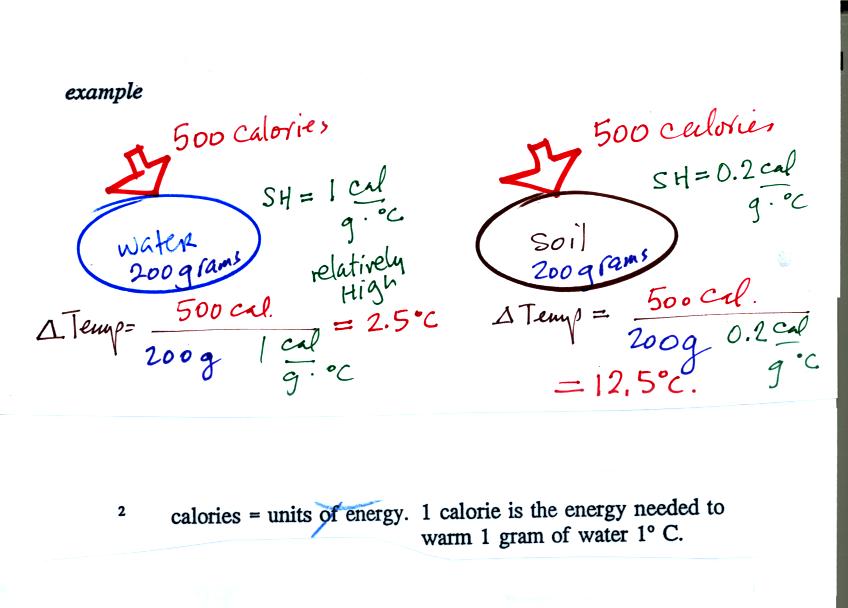
Here's an example that shows the effect of specific
heat. Equal
amounts of energy (note that calories are units of energy) are added to
equal masses of water and dirt. We use water and dirt in the
example because most of the earth's surface is either water or dirt.
Water has a higher specific heat than soil, it only warms up 2.5
C.
The soil warms up 12.5 C, five times as much.
These
different rates of warming of water and soil have important
climate implications.
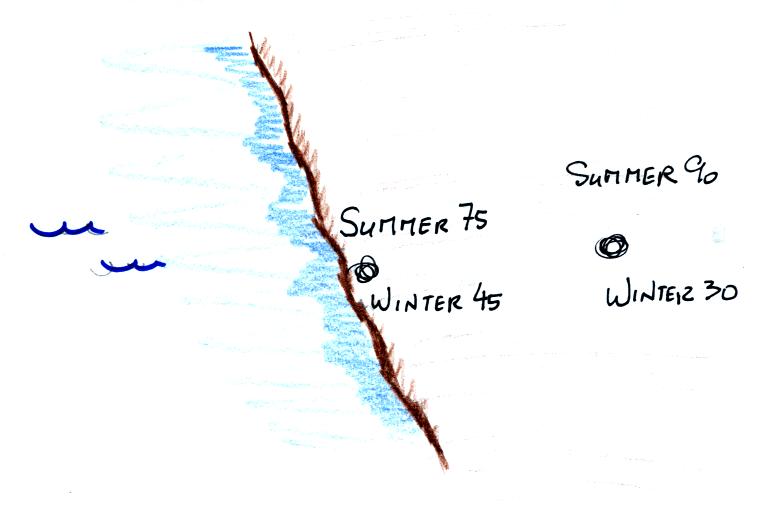
Oceans moderate the climate. Cities near a large body
of water won't warm as much in the summer and won't cool as much during
the winter compared to a city that is surrounded by land.
The city above on the
coast has a 30o F annual range of temperature. The
city further
inland (assumed to be at the same latitude and altitude) has an annual
range of 60o F. Note that both cities have the same 60o
F annual
mean temperature.
Proximity to land or water is one of three or
four factors that determine a region's climate. Latitude and
altitude also play important roles. This is discussed in Chapter
3 and will probably be a topic on a future Optional Homework Assignment.
We did a
short experiment in class. The object of the experiment was to
measure the latent heat of
vaporization of liquid nitrogen. That just means measuring the
amount of energy needed to evaporate a gram of liquid nitrogen.
The students that are doing Experiment #2 are measuring the latent heat
of fusion of ice, the energy needed to melt one gram of ice.

We poured some water into a styrofoam cup and weighed it
(167.9 grams) and measured its
temperature (22.5 C). Then we weighed out 31 grams of liquid
nitrogen into a second cup and poured it into the cup of water (after
having removed the thermometer). We waited until all the liquid
nitrogen had evaporated and remeasured the temperature of the water.
It takes energy to turn liquid nitrogen into nitrogen gas.
The needed energy came from the water (we assume that because the
experiment was performed in a styrofoam cup that the warm room air
didn't contribute any energy).
When energy was removed
from the water the water cooled to 12.2 C. Because we knew how
much water we started with, its temperature drop, and water's specific
heat we calculated how much
energy was taken from the water. That is the 1729 calorie
figure above. This was used to evaporate 31 grams of liquid
nitrogen. So we divided 1729 calories by 31 grams to get 55.8
calories needed per gram. That is our
measured value of the latent heat of vaporization of nitrogen.
The know value is 48 cal/g, so our measurement
was reasonably close.

The figure above is on p. 46 in the photocopied Class
Notes. Temperature provides a measure of the average kinetic of the
atoms or
molecules in a material.
You can think of heat as being the total kinetic energy of all
the
molecules or atoms in a material.
The next figure might make the distinction between temperature (average
kinetic energy) and heat (total kinetic energy) clearer.

A cup of water and a pool of water both have the same
temperature. The average kinetic energy of the water molecules in
the pool and in the cup are the same. There are a lot more
molecules in the pool than in the cup. So if you add together all
the kinetic
energies of all the molecules in the pool you are going to get a much
bigger number than if you sum the kinetic energies of the molecules in
the cup. There is
a lot more stored energy in the pool than in the cup.
In the same way the two groups of people shown have the same average
amount
of money per person ($10 per person). The $100 held by the group
at the left is
greater than the $20 total possessed by the smaller group of people on
the right. If you wanted to raise the average amount of money per
person in the group at left from $10 to $11 it would cost you
$10. It would only cost $2 to raise the average amount of money
to $11 in the group at right.
You need to be careful what temperature scale you use when using
temperature as a measure of average kinetic energy. You must
use the Kelvin temperature scale because it does not go
below zero. THe smallest kinetic energy you can have is zero
kinetic energy. There is no such thing as negative kinetic energy.

You should remember the temperatures of the boiling point
and freezing
point of water on the Fahrenheit, Celsius, and Kelvin scales. 300
K is a
good easy-to-remember value for the global annual average surface
temperature of the earth.
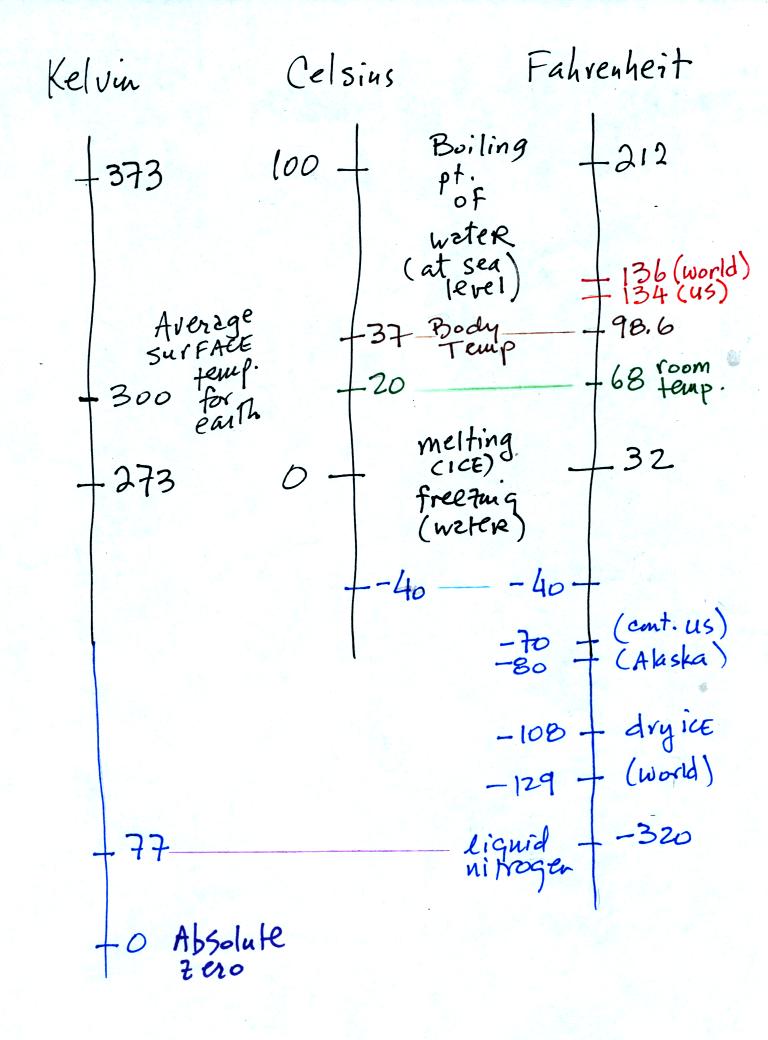
You certainly don't need to try to remember all these
numbers. The world high temperature record was set in Libya, the
US
record in
Death Valley. The continental US cold temperature record of -70 F
was set in Montana and the -80 F value in Alaska. The world
record -129 F was measured at Vostok station in Antarctica. This
unusually cold reading was the result of three factors: high latitude,
high altitude, and location in the middle of land rather than being
near or
surrounded by ocean. You'll find more record high and low
temperature data on p. 58 and p. 61 in Chapter 3 of the text.
Precipitation records are shown on p. 358. Note that even liquid
nitrogen is still quite a bit warmer than absolute zero.
The
following information wasn't covered in class on Tuesday. We will
cover it quickly at the beginning of class on Thursday.
Conduction is the first of four energy transport processes
that we
will cover. The figure below illustrates this process. A
hot object has been stuck in the middle of some cooler air.

In the first picture the
random haphazard motions of the atoms or
molecules near the object have caused them to collide with and pick up
energy from the object. This is reflected by the increased speed
of motion or increased kinetic energy of these molecules or
atoms (these guys are colored red). In the middle picture the
initial bunch of
energetic molecules have
collided with some of their neighbors and shared energy with
them (these are orange). The orange molecules have more
energy than they did but they don't
have as much energy as the red colored molecules next to the hot
object. In
the third picture molecules further from the object now have gained
some energy (the yellow ones). The random motions and collisions
between molecules
is carrying energy from the hot object out into the colder material.
Conduction transports energy from hot to cold. The rate of
energy transport depends first on the material (air in the example
above). Thermal
conductivities of some common materials are listed. Air is a very
poor conductor of energy. Air is generally regarded as an
insulator. Water is a little bit better conductor. Metals
are generally very good conductors (sauce pans are often made of
stainless steel but have aluminum or copper bottoms to evenly spread
out heat when placed on a stove). Diamond has a very high
thermal conductivity. Diamonds are sometimes called "ice."
They feel cold when you touch them. The cold feeling is due to
the fact that they conduct energy very quickly away from your warm
fingers when you touch them.
The rate of energy transport also depends on temperature
difference. If the object in the picture had been warm rather
than hot, less energy would flow or energy would flow at a slower into
the surrounding material.
The next figure shows a demonstration mentioned but not
performed in
class. It involves
opening a bottle of something with a
strong
smell such as glacial acetic acid (acetic
acid gives vinegar its characteristic smell) in the front of the
classroom. With time the odor would eventually spread throughout
the class
room. This is an example of diffusion. The acetic acid
molecules would be moved through the room by random collisions with air
molecules. In many respects this is like the conduction of
heat. The demonstration wasn't performed because the
concentration of the acetic acid in the air, at least in the front of
the room, would be high enough to present a serious risk to the
instructor and students.

The acetic acid is beginning to evaporate into
the
air. Collisions with air molecules would begin to move the acetic
acid molecules toward the back of the room.
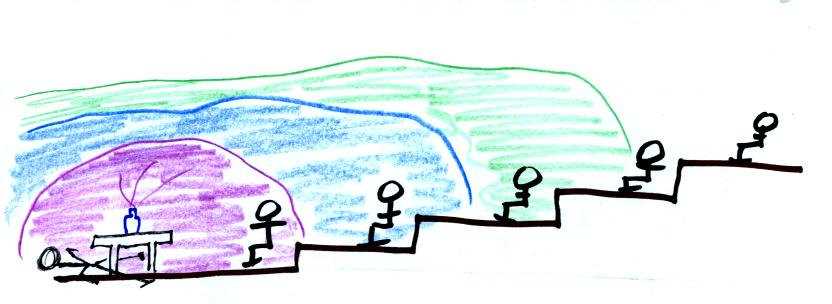
The instructor has lost
consciousness because of the
strong odor of the acetic acid in the front of the room.
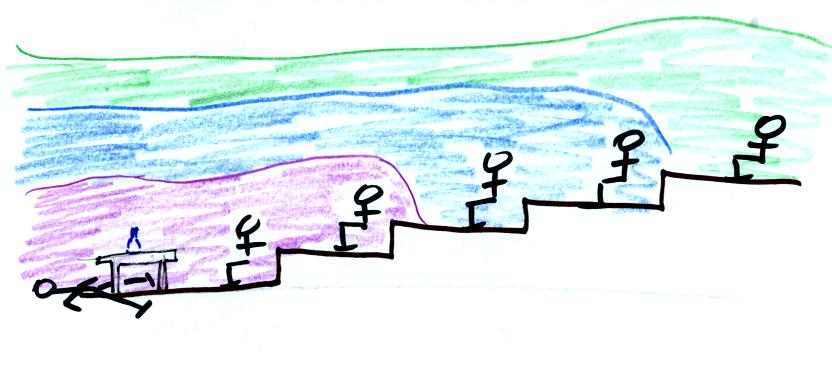
The odor would eventually spread
throughout the class
room.
Convection
is the next energy transport process we need to look at. Rather
than moving about randomly, the atoms or molecules move as a
group. Convection works in liquids and gases but not solids.
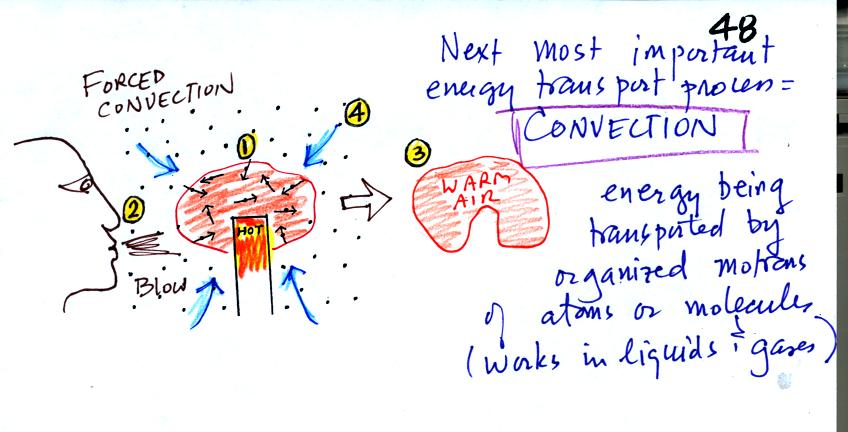
At Point 1 in the picture above a thin layer of air
surrounding a hot object has
been
heated by conduction. Then at Point 2 a person (yes that is a drawing
of a
person's head) is blowing the blob of warm air
off to the right. The warm air molecules are moving away at Point
3 from the
hot object together as a group (that's the organized part of the
motion). At Point 4 cooler air moves in and surrounds the hot
object and the cycle can repeat itself.
This is forced
convection. If you have a hot object in your hand you could just
hold onto it and let it cool by conduction. That might take a
while because air is a poor conductor. Or you could blow on the
hot object and force it to cool more quickly.
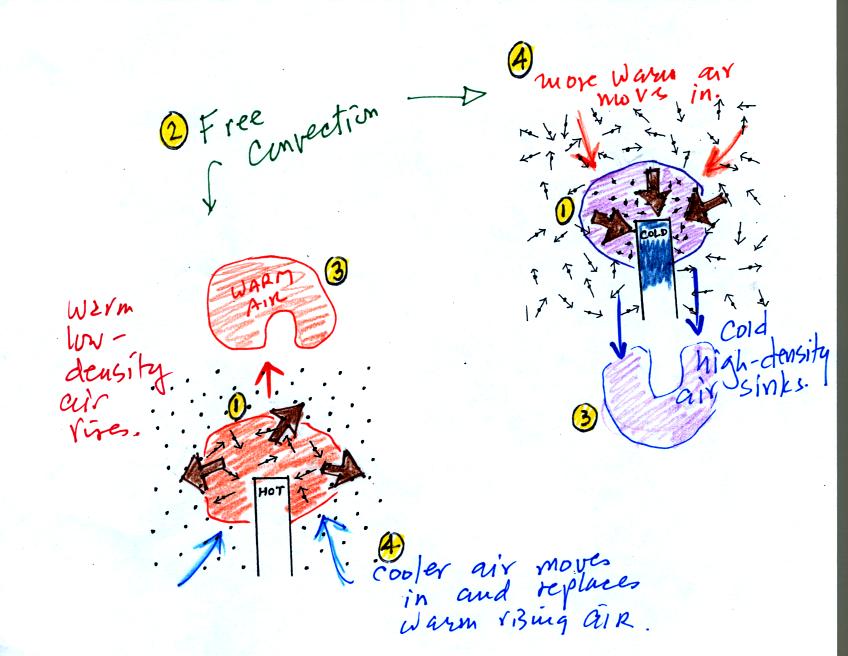
A thin layer of air at Point 1 in the figure above (lower left) is
heated by conduction. Then because hot air is also
low density air, it actually isn't necessary to blow on the hot object,
the
warm air will rise by itself (Point 3). Energy is being
transported away
from the hot object into the cooler surrounding air. This is
called free convection and
represents another way of causing rising air motions in the atmosphere
(rising air motions are important because rising air expands as it
moves into lower pressure surroundings and cools. If the air is
moist, clouds can form). Cooler air moves in to take the place of
the rising air at Point 4 and the process repeats itself.
The example at upper right is also free convection. The
sinking
air motions that would be found around a cold object have the effect of
transporting energy from the warm surroundings to the colder object.
Because
air has such a low thermal conductivity it is often used as an
insulator. It is important, however, to keep the air trapped in
small pockets or small volumes so that it isn't able to move and
transport energy by convection. Here are some examples of
insulators that use air:

Foam contains lots of small bubbles of air
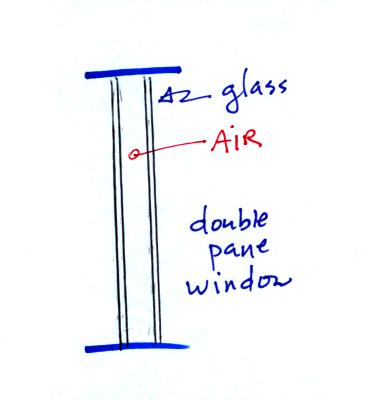
Double pane windows are used in many homes and buildings to
conserve
energy. A thin layer of air is trapped between two panes of
glass. Window manufacturers also use a variety of other techniques
to make the windows even better insulators.

A tangled mess of hollow fibers (eg. hollofil) is often used
in
sleeping bags or winter jackets.
Now some
practical applications of what we have learned about conductive and
convective energy transport.
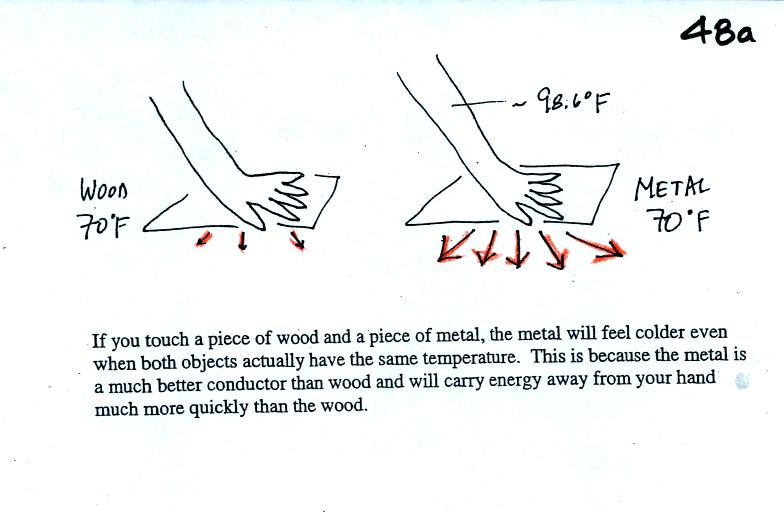
Metals are better conductors than wood. If you touch a
piece of
70 F metal it will feel colder than a piece of 70 F wood. A piece
of 70 F diamond would feel even colder because it is a better conductor
than metal. Something that feels cold may not be as
cold as it seems. Our perception of cold is more an
indication of how
quickly our hand is losing energy than a reliable measurement of
temperature.
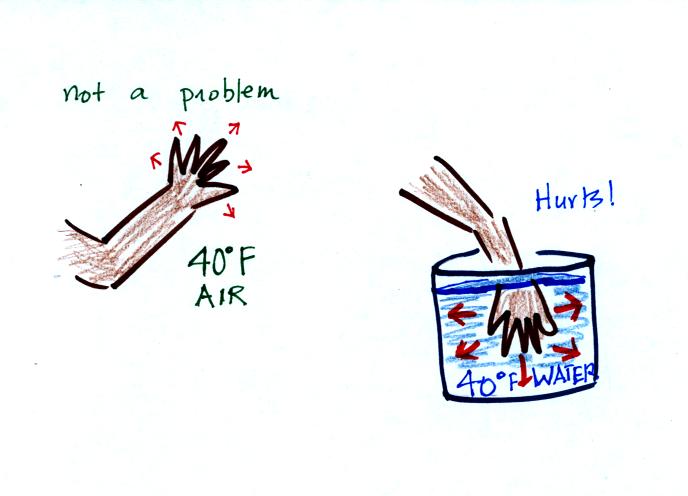
Air is a poor conductor. If you stick your hand out in
40 F
weather the air won't conduct energy away from your hand very quickly
at all and the air won't feel very cold. If you stick your hand
into a bucket of 40 F water, it will feel very cold (your hand will
actually soon begin to hurt). Water is a much better conductor
than air. Energy flows much more rapidly from your hand into the
cold water.
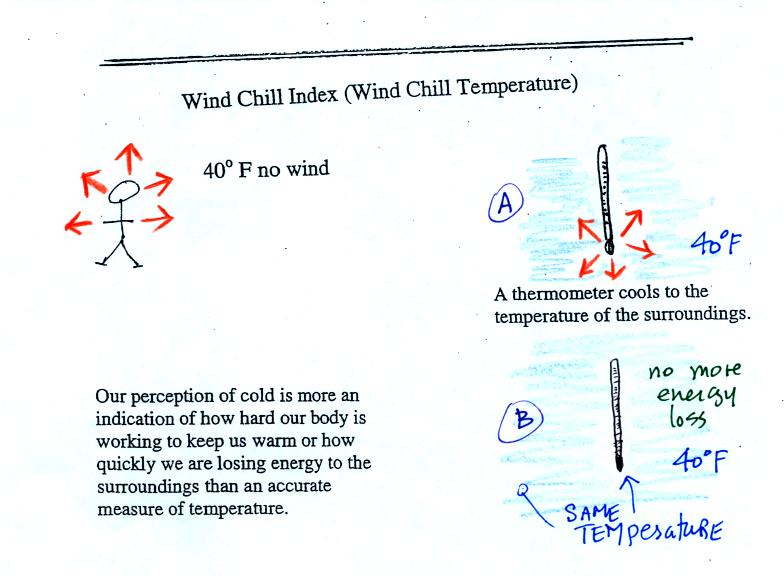
If you go outside on a 40 F day (calm winds) you will feel
cool; your
body is losing energy to the colder surroundings (by conduction
mainly). A thermometer
behaves differently. It actually cools to the temperature of the
surroundings. Once it reaches 40 F it won't lose any additional
energy.

If you go outside on a 40 F day with 30 MPH winds your body
will lose
energy at a more rapid rate (because convection together with
conduction are transporting energy away from your body). It will
feel colder than a 40
F day
with calm winds. Actually, in terms of the rate at which your
body loses energy, the windy 40 F day would feel the same as a calm 28
F day. The combination 40 F and 30 MPH winds results in a wind
chill temperature of 28 F.
The thermometer will again cool to the
temperature of its surroundings, it will just cool more quickly on a
windy day. Once the thermometer reaches 40 F there won't be any
additional energy flow. The
thermometer would measure 40 F on both the calm and the windy day.
Standing outside on a 40 F day is usually not a life threatening
situation. Falling into 40 F water is.

Energy will be conducted away from your body more quickly
than your
body can replace it. Your core body temperature will drop and
bring on hypothermia.
Be sure not to confuse hypothermia with hyperthermia which can bring on
heatstroke and which is probably a more serious outdoors risk in S.
Arizona.




























